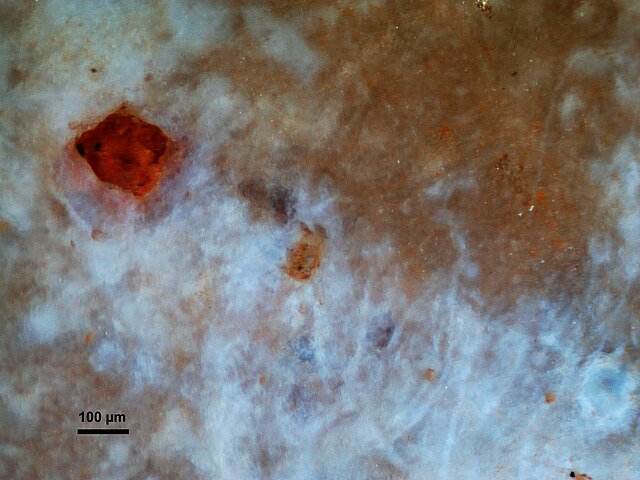A biofilm is a syntrophic community of microorganisms in which cells stick to each other and often also to a surface. These adherent cells become embedded within a slimy extracellular matrix that is composed of extracellular polymeric substances (EPSs). The cells within the biofilm produce the EPS components, which are typically a polymeric combination of extracellular polysaccharides, proteins, lipids and DNA. Because they have a three-dimensional structure and represent a community lifestyle for microorganisms, they have been metaphorically described as "cities for microbes".
Staphylococcus aureus biofilm on an indwelling catheter
Probable cyanobacteria in the vertical section of a silicified biofilm from the Lower Cretaceous. Very shallow hypersaline environment of the Urgonian carbonate platform of Provence, south eastern France.
Biofilm of golden hydrophobic bacteria; ceiling of Golden Dome Cave, a lava tube in Lava Beds National Monument
Five stages of biofilm development (1) Initial attachment, (2) Irreversible attachment, (3) Maturation I, (4) Maturation II, and (5) Dispersion. Each stage of development in the diagram is paired with a photomicrograph of a developing P. aeruginosa biofilm. All photomicrographs are shown to the same scale.
A microbial consortium or microbial community, is two or more bacterial or microbial groups living symbiotically. Consortiums can be endosymbiotic or ectosymbiotic, or occasionally may be both. The protist Mixotricha paradoxa, itself an endosymbiont of the Mastotermes darwiniensis termite, is always found as a consortium of at least one endosymbiotic coccus, multiple ectosymbiotic species of flagellate or ciliate bacteria, and at least one species of helical Treponema bacteria that forms the basis of Mixotricha protists' locomotion.
Workflow of enrichment and dilution-to-extinction cultures to select simplified microbial consortia (SMC) for keratin degradation.
Painting of a cross-section through an Escherichia coli bacterium, a chemoheterotrophic bacterium often used in synthetic microbial consortia.






